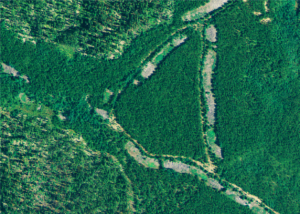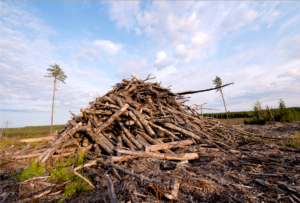KEY MESSAGES:
- New numbers show that approximately 21,700 ha are deforested each year in Ontario due to roads and landings imposed by forestry in the boreal forest (~40,000 football fields)
- This is seven times greater than the reported deforestation rate by forestry for all of Canada despite the fact that only 17% of Canada’s logging takes place in Ontario
- Findings undermine the claim of ‘near zero deforestation’ in Canada
- A massive area of productive forest, 650,000 ha, has been lost in last 30 years due to this logging infrastructure, equivalent to 10 times the size of the city of Toronto
- By 2030, this loss of productive forest in this one province alone is on track to cost the atmosphere 41 Mt C02 equivalent in foregone carbon removals, more than a year of emission from all the passenger vehicles in Canada
- This means that Canada has a growing carbon debt from clearcut logging and is underreporting these impacts on the international stage

TORONTO – As the latest UN Climate Change Conference (COP 25) opens in Spain this week, a new investigation reveals Canada’s deforestation by forestry is much larger than what was previously known.
The study reports for the first time that approximately 21,700 ha are deforested each year in the boreal forest of Ontario which is seven times greater than the reported rate of deforestation by forestry for all of Canada (average is approx. 2,800 ha/year). This is despite the fact only 17% of Canada’s logging takes place in that province.
“When we extrapolate the findings of this study, an estimated 650,000 ha of productive forest have been lost due to logging infrastructure over the past 30 years in Ontario alone,” observes Trevor Hesselink, lead author of the study.
“That’s a staggering loss, equivalent to 10 times the area of the City of Toronto or 8 times the area of New York City,” says Janet Sumner, Executive Director for Wildlands League, a leading conservation group in Canada.
The associated carbon cost is nationally significant and already represents 16.5 Mt C02 equiv. of lost carbon sequestration in the last 30 years. This is how much carbon dioxide would have been taken up by growing trees had roads and landings not displaced them.
And it’s a cost that is projected to grow to 41 Mt C02 equiv. by 2030, which is more than a year of emissions from all the passenger vehicles in Canada.

“We’ve been told over and over that Canada has a near zero deforestation rate,” says Sumner. “But it wasn’t what we were seeing in the bush. So we took a closer look. And now we know. Canada does indeed have a deforestation problem and one we need to fix,” Sumner added.
“Canada’s logging deforestation problem has been ignored, due to an optimistic belief that all affected areas will grow back – an assumption that has long skirted systemic scrutiny,” said Hesselink, who is also the Director of Policy and Research for Wildlands League.
The study being released today, titled Boreal Logging Scars: an extensive and persistent logging footprint in typical clearcuts of northwestern Ontario, Canada measured the long-term impacts of roads and roadside footprints (i.e., landings, pull offs, roadside pits and staging areas) from clearcut logging in the boreal forest.
It reveals that in the first three decades after clearcut logging, roads and landings typically remain essentially barren and dominated by grasses and low shrubs. The numbers, based on remote sensing, aerial photography and geospatial analysis, were also verified by fieldwork.
The main culprit is a deeply wasteful practice resulting from full-tree harvesting (FTH), where the entire tree (trunk, limbs and branches) are dragged from the stump to the roadside. At roadside, merchantable logs are stripped of branches and tops, undesired species are left behind and tree waste accumulates in large volumes, and on large spaces, inhibiting renewal of the forest.
FTH is the dominant approach to clearcut logging in Ontario and is also used in the British Columbia interior, across Alberta and the prairie provinces and in about 50% of the logging in Quebec, raising additional concerns that the Wildlands League study may be the tip of the iceberg when it comes to the revealing the true scale of deforestation by forestry in Canada.
Wildlands League is asking the government of Canada to revise its rules for monitoring deforestation to address the substantial risks and impacts from logging roads and landings in the boreal forest; and, to review and remedy its current under-reporting of the carbon impacts from Canadian logging on the international stage.
“Given these findings, it’s clear to me forestry should no longer be permitted to open up the last remaining intact boreal forests in Canada in a climate crisis,” Sumner said.
Downloads:
- The Executive Summary.
- Part One of the report: a high res version of the Summary for Decision Makers. Note it’s 325 MB.
- Part Two of the report: a high res version of the Technical supporting materials. Note it’s 650 MB.
- Boreal Logging Scars – site coordinates. Note it’s 185 MB.
For high res photos, please click here or contact Anna below.
-30-
For more information please contact:
Anna Baggio, Director, Conservation Planning 416-453-3285 mobile or by email anna (insert at symbol) wildlandsleague.org.

